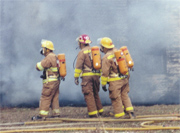What should we do during a chemical emergency?
 If emergency officials recommend that people in your area Shelter-in-Place, you should stay inside and encourage customers, vendors, and others to do the same. Allow people from outside to Shelter-in-Place in your home or workplace. Begin implementing your site emergency plan. For a Shelter-in-Place emergency, you will need to stay inside until the chemical leak has stopped and winds have dissipated any vapors in the vicinity.
If emergency officials recommend that people in your area Shelter-in-Place, you should stay inside and encourage customers, vendors, and others to do the same. Allow people from outside to Shelter-in-Place in your home or workplace. Begin implementing your site emergency plan. For a Shelter-in-Place emergency, you will need to stay inside until the chemical leak has stopped and winds have dissipated any vapors in the vicinity.
How will we know when the emergency is over?
City officials will announce the All Clear via the news media, so keep monitoring your radio. There is no separate safety siren signal for All Clear. The sirens were not designed to be heard indoors.
After the All Clear is announced, you can open your windows and doors to air out your building.
When are the sirens tested?
The sirens are tested every Monday at 12:30 p.m. They only sound for about one minute during the test, but will sound for three minutes during a real event.
How can I better promote Shelter-in-Place safety in my place of work?
- If a major chemical release occurred, local emergency officials would notify people to Shelter-in-Place as a protective action. Shelter-in-Place means to go inside, close doors and windows, shut off heating or air conditioning systems and take any other steps necessary to prevent contaminated outside air from entering the building. Businesses have unique challenges during such an event. Employees need to be trained to know what to do. Customers and vendors will need instructions. What if people on the street enter your business looking for a place to get indoors?
- To assist businesses with these challenges and help them get prepared for a Shelter-in-Place event, CAER (Community Awareness and Emergency Response) suggests local businesses develop a Shelter-In-Place plan.
- Every business should develop a written emergency plan that includes what to do in case the safety sirens sound or a Shelter-in-Place advisory is issued, just as the plan covers what to do in case of a fire or tornado. A harmful chemical could be accidentally released from an industrial processing or storage facility, or during transportation from a spill involving a pipeline, railcar or truck. Chemical releases can also occur from municipal wastewater treatment facilities that utilize ammonia or even a community swimming pool that still uses chlorine.
To obtain more information on how to build your plan, contact CAER at (519) 332-2010. CAER can also provide speakers or onsite mentoring to assist with emergency planning.
